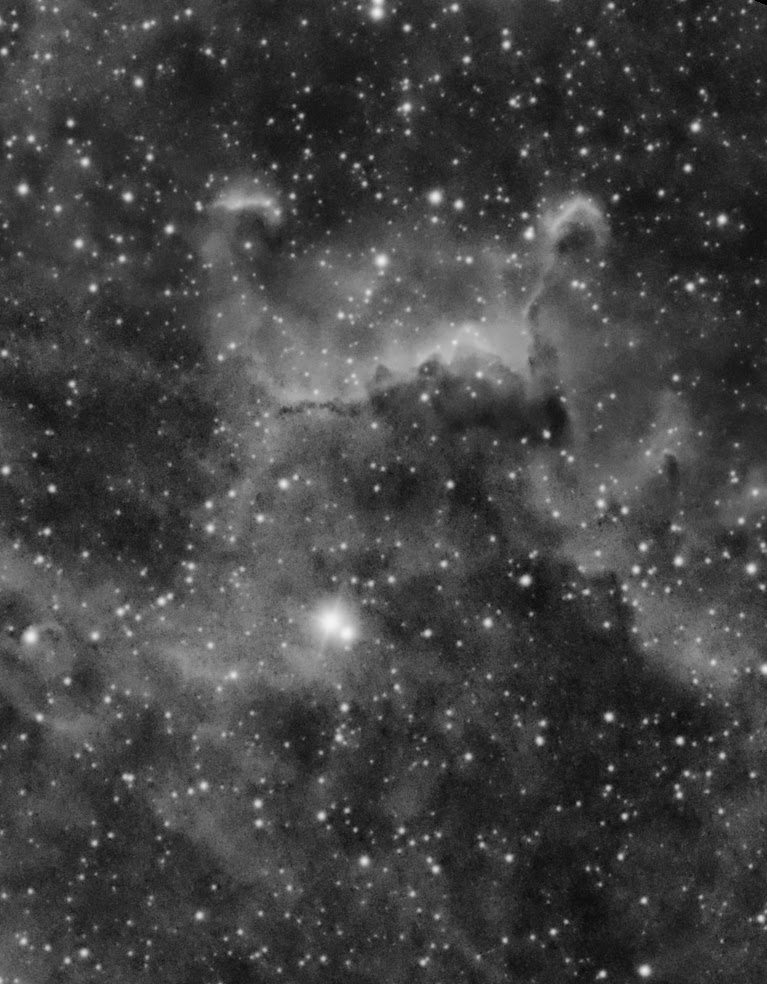The problem of making nice looking
photos (to my own eyes and contact lenses) is that I want to make
more photos, extend the field of view a bit more in this or that
direction, maybe reach to include the next nice object in the same
field of view without losing resolution. There is already a solution
to that: mosaics. But nice things come to a price, and in this case
the big price is the time and efforts required to build a mosaic. I
have done it a few times, not always sucessfully... By the way I need
to report here the great mosaic of Orion and Monoceros that my friend
Daniel Trueba and myself produced a couple of winters ago...
So far the mosaic of which I was
proudest was this one already reported in this blog:
And I'm still quite happy with it. That
took me almost 80 hours of exposure. The one I present here “only”
63 hours, but the completion has been much longer. In part due to
unexpected issues like a computer crash in which I lost some
processed panels, and also a change in telescope. But eventually it
came out reasonably well, I believe.
The mosaic contains nine panels in a
3x3 shape. Important details are as follows:
Field
of view ..... 2d 52' 2.9" x 3d 43' 53.2"
Image
center ...... RA: 05 27 49.182 Dec: +34 22 00.83
Image
bounds:
top-left
....... RA: 05 35 04.787 Dec: +36 11 35.58
top-right
...... RA: 05 20 52.515 Dec: +36 14 39.36
bottom-left
.... RA: 05 34 27.470 Dec: +32 27 57.93
bottom-right
... RA: 05 20 52.294 Dec: +32 30 53.77
This info was obtained after I resolved
it with Pixinsight 1.8. The mosaic is in Auriga, and it goes from
well known objects like the cluster M38 to the emission nebula IC410
(with the well known “Tadpoles”), plus other less known objects,
as seen below in the annotated image. The smaller cluster M36 is just
outside teh image to teh left, and the also gamous IC405 is not far
to the right. North is up.
Eight out of the nine panels were made
with the Takahashi FS102 and the reducer at f/6. Then in spring of
2013, Auriga dissapeared from the sky... In June I changed from the
FS102 to the Astro-Physics GT 130, which at f/6 has a focal length of
800mm and therefore a smaller field of view. So in winter of 2013 I
took the last, ninth panel, but it was smaller thanb the others. That
gave me a lot of headaches. Eventually I managed to attach it to the
others, trimming the image a bit (that is when M36 has to be left
out).
Obvioulsly the panel is only in
H-alpha. Maybe I'll collect some OIII photons, and SII, of part of
the image (IC405 for example), but that would be another story. I
like it in black and white. This a question of taste... I know that
the general public likes to see colors (confirmed by Dave Eicher,
editor in chief of the Astronomy magazine during the Starmus 2014
astrophotography course, just one week ago...) but I have been
educated in B&W photography and still like its dramatic power.
You can see it also in Astrobin at higher resolution:
Apart from the telescope, already
discussed, the rest of the equipment has been the usual one:
QSI 683 camera with Astrodon H-alpha
filter, 5nm
Mount ASA DDM60pro, no guiding
Acquired with Maxim DL, Processed with
Pixinsight 1.7 and 1.8
And, hidden in the vast network of hydrogen wisps, an amazing creature is hidden, like an abisal fish. Below there is a detail of it. Can you find it in the large picture?



Pedazo de fotos Jesus... la verdad admirable trabajo, saludos Miquelin... desde los DuPonters del edificio W.
ResponderEliminar